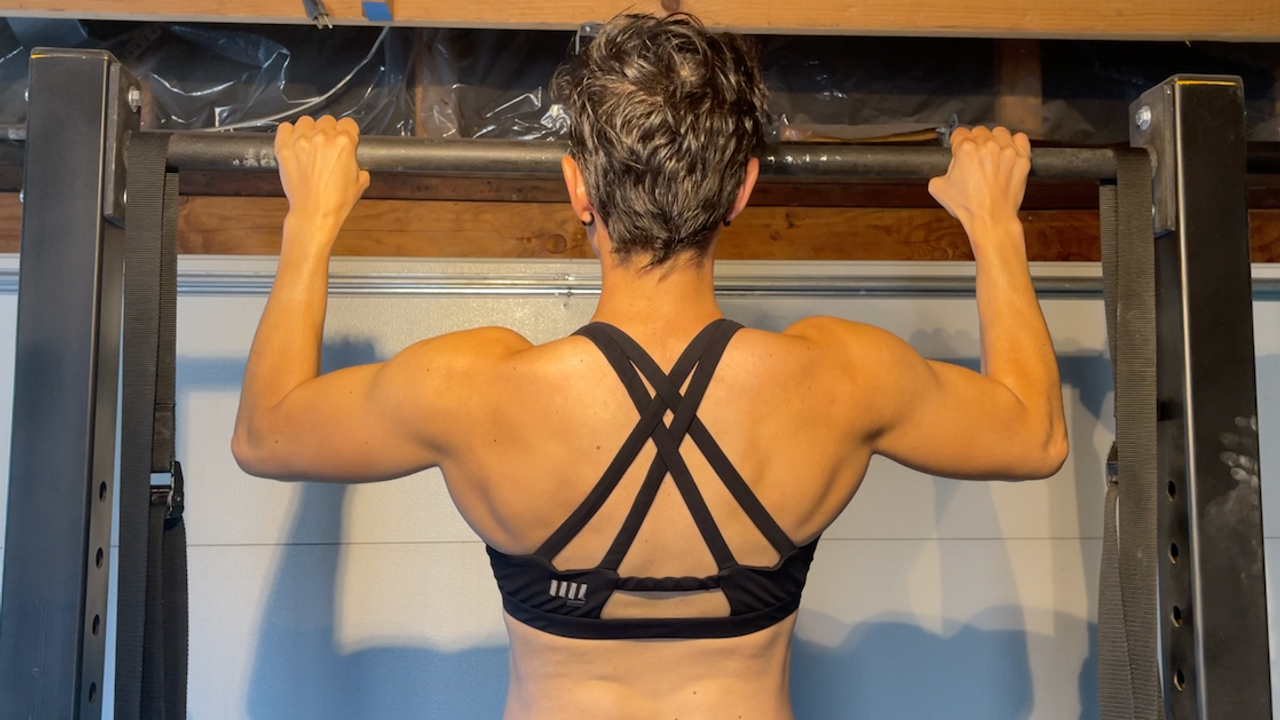
HOW TO GET YOUR FIRST PULL UP
Sep 10, 2021Click here to sign up for the Modus Athletica x Garage Gym Girl Pull Up Program!
Getting your first pull-up may seem like an impossible feat, but the key is to remember that it is a skill that can be trained. With the right set of tools, consistent work, and a growth mindset, anyone can pull their chin over the bar. A pull-up is a complex movement that requires the coordination of multiple muscle groups. In this post, we’ll walk you through steps to hone your technique while also developing your pulling strength. With any new workout, it’s crucial to stay balanced, so we’ll also give you some tips to avoid overuse and injury. Pulling joins the squat, hinge, and push as one of the four basic movement patterns, making it essential to any program. It helps build general strength that translates into your favorite activities, whether you like to climb, play tennis, or do gymnastics in the park. If your training is primarily handstands, adding in some pulling work will be a perfect complement to your program.
Our hanging and shoulder mobility program is the perfect place to start your pull-up journey!
PROGRESSIONS TO A COMPLETE PULL-UP
Start incorporating the movements below 2-3 times per week. As you practice, play around with different grips, using both the chin-up and pull-up positions.
Build strength with horizontal pulls
If you’re just starting, focus on horizontal pulls like the bodyweight row (the second movement in this video). While completing the row, keep your core tight and squeeze your shoulder blades together as you pull your chest toward the rings. This can be done using rings, a bar, or even by pulling from under your kitchen table!
- Do 3 sets of 6-8 reps. Rest about 2 minutes between sets.
- You can lower or raise the rings to make the rows more or less difficult. Find a position that is challenging but still allows you to complete 8 reps with good form.
Learn the movement with assisted pull-ups
Using a chair or a partner for assistance allows you to go through the entire range of motion of the pull-up while you’re building strength. This is the time to focus on perfecting your technique. Start with straight arms, pull your shoulders down and back, engage your core, and avoid swinging your legs as you pull your chin all the way over the bar.
- Do 3 sets of 6-8 reps. Rest about 2 minutes between sets.
Options for assistance:
- Keep your feet on a block or a chair below the bar while you complete a pull-up. Try to put only as much weight into your feet as you need to finish the reps!
- Bend your knees and have a partner stand behind you and hold your feet. They can give you as much or as little assistance as you need to do the movement.
NOTE: Sometimes folks will use a resistance band for assistance. This method provides the most help at the initiation, or bottom, of your pull. Using a band while learning the pull-up will prevent you from building the strength you need to start from a hanging position.
Work up to bodyweight with eccentrics and isometric holds.
Practicing eccentrics, or lowering from the top position, requires you to control your entire bodyweight, but it’s easier to complete than a pull-up. Jump or use a chair to get your chin over the bar. Hold there for a second, then slowly lower down, ending in a dead hang. Controlling your movement is key with eccentrics; you can still use a box or a partner for assistance if needed.
- Do 6-8 sets of 1-3 reps. Rest 2 minutes between sets.
Adding in isometric (static) holds at different points in your pull-up can also help you build strength with full bodyweight.
- Start by holding at the top position for ten seconds, with your chin over the bar.
- Add in isometric holds at different arm angles, especially if you’re noticing weakness in certain positions. Options include hanging with your elbows bent at 90 degrees or with your eyes level with the bar.
STAY BALANCED AND LOAD PROGRESSIVELY
Introducing a lot of pulling into your program without paying attention to other movements can lead to overuse and injury. Make sure to stay balanced by targeting the stabilizing muscles in your shoulders and including pushing in your program.
Push while you pull
While training your pull-up, maintain about a 2:1 pull to push ratio. There are several bodyweight options, including regular push-ups, inverted push-ups, and handstands. You can also use the chest press or bench press for options using weights.
Stabilize
Warm-up with scapular pull-ups (the first movement shown in this video). Starting from a dead hang, pull your shoulders down and back, away from your ears. Hold this position for a second, then slowly lower back to a dead hang. Practicing this motion strengthens the stabilizing muscles in your shoulders and will help with the initiation of your pull-up.
- Add 10-12 reps into your daily warm-up
Consistency is key
Our bodies adapt over time to the activities we ask of them. Weeks (and months!) of consistent effort will get you to your goal. Make a habit of practicing your pull-up, or strength training in general, by stacking your workout onto an existing habit.
As you practice these movements, you will be getting stronger. Enjoy the process of learning as you put in the work to get your first pull-up!
Want to nail your pull up? We’ll take you through multiple phases of strength training, including a power phase, which sets it apart from similar offerings. Build a better athletic profile ready for your next climbing trip, tree-climbing mission, or pull-up competition!

